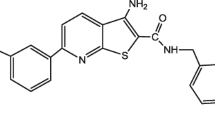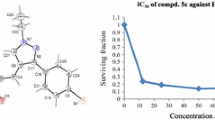Abstract
A novel series of N-arylpyrazole derivatives (5a–5d, 7a–7c) has been designed and synthesized via aromatic substitution reaction of N-nonsubstituted pyrazoles with 4-fluoronitrobenzene in the presence of base. The structures of these compounds were established on the basis of elemental (C, H, and N) and spectral analysis (1H NMR, 13C NMR, HRMS, and FT-IR). All the compounds were tested for their cytotoxic activity in vitro against four human tumor cell lines: carcinoma (Bel-7402), nasopharyngeal carcinoma (KB), immature granulocyte leukemia (HL-60), and gastrocarcinoma (BGC-823) by the 3-(4,5-dimethylthiazol-2-yl)-2,5-diphenyltetrazolium bromide assay. The results showed that most of the obtained compounds exhibited promising cytotoxicity against tested carcinoma cell lines with low IC50 values. The bis-pyrazole derivative 7c, bearing alkoxy group on the 5-position of phenyl ring, was the most effective one. It is inhibition of cell growth of Bel-7402 cells was 1.5-fold higher than that found for cisplatin. And, also mono-pyrazole derivatives 5a and 5b, decorated with trifluoromethyl group on the phenyl ring, displayed better cytotoxicity than that of cisplatin against Bel-7402 cell line.

Similar content being viewed by others
References
Balbi A, Anzaldi M, Macciò C, Aiello C, Mazzei M, Gangemi R, Castagnola P, Miele M, Rosano C, Viale M (2011) Synthesis and biological evaluation of novel pyrazole derivatives with anticancer activity. Eur J Med Chem 46(11):5293–5309
Barton CC, Daves GF, Franceschi G (1980) A new synthetic approach towards adriamycin. J Chem Soc, Perkin Trans 1:643–647
Bebernitz GR, Argentieri G, Battle B, Brennan C, Balkan B, Burkey BF, Eckhardt M, Gao JP, Kapa P, Strohschein RJ, Schuster HF, Wilson M, Xu DD (2001) The effect of 1,3-diaryl-[1H]-pyrazole-4-acetamides on glucose utilization in ob/ob mice. J Med Chem 44(16):2601–2611
Bing RJ, Lomnicka M (2002) Why do cyclo-oxygenase-2 inhibitors cause cardiovascular events? J Am Coll Cardiol 39(3):521–522
Bouabdallah I, AitM’Barek L, Zyad A, Ramdani A, Zidane I, Melhaoui A (2007) New pyrazolic compounds as cytotoxic agents. Nat Prod Res 21(4):298–302
Chang KT, Choi YH, Kim SH, Yoon YJ, Lee WS (2002) Regioselective synthesis of pyrazoles via the ring cleavage of 3-substituted N-alkylated 3-hydroxyisoindolin-1-ones. J Chem Soc, Perkin Trans 1:207–210
Chowdhury MA, Abdellatif KRA, Dong Y, Das D, Suresh MR, Knaus EE (2009) Synthesis of celecoxib analogues possessing a N-difluoromethyl-1,2-dihydropyrid-2-one 5-lipoxygenase pharmacophore: biological evaluation as dual Inhibitors of cyclooxygenases and 5-lipoxygenase with anti-inflammatory activity. J Med Chem 52(6):1525–1529
Elgemeie GH, Zaghary WA, Amin KM, Nasr TM (2005) New trends in synthesis of pyrazole nucleosides as new antimetabolites. Nucleosides Nucleotides Nucleic Acids 24(8):1227–1247
Farag AM, Mayhoub AS, Barakat SE, Bayomi AH (2008) Regioselective synthesis and antitumor screening of some novel N-phenylpyrazole derivatives. Bioorg Med Chem 16(2):881–889
Finn J, Mattia K, Morytko M, Ram S, Yang YF, Wu XM, Mak E, Gallant P, Keith D (2003) Discovery of a potent and selective series of pyrazole bacterial methionyl-tRNA synthetase inhibitors. Bioorg Med Chem Lett 13(13):2231–2234
Genin MJ, Biles C, Keiser BJ, Poppe SM, Swaney SM, Tarpley WG, Yagi Y, Romero DL (2000) Novel 1,5-diphenylpyrazole nonnucleoside HIV-1 reverse transcriptase inhibitors with enhanced activity versus the delavirdine-resistant P236L mutant: lead identification and SAR of 3- and 4-substituted derivatives. J Med Chem 43:1034–1040
Giacomelli G, Porcheddu A, Salaris M, Taddei M (2003) Microwave-assisted solution-phase synthesis of 1,4,5-trisubstituted pyrazoles. Eur J Org Chem 3:537–541
Habeeb AG, Rao PNP, Knaus EE (2001) Design and synthesis of celecoxib and rofecoxib analogues as selective cyclooxygenase-2 (COX-2) inhibitors: replacement of sulfonamide and methylsulfonyl pharmacophores by an azido bioisostere. J Med Chem 44(18):3039–3042
Insuasty B, Tigreros A, Orozco F, Quiroga J, Abonía R, Nogueras M, Sanchez A, Cobo J (2010) Synthesis of novel pyrazolic analogues of chalcones and their 3-aryl-4-(3-aryl-4,5-dihydro-1H-pyrazol-5-yl)-1-phenyl-1H-pyrazole derivatives as potential antitumor agents. Bioorg Med Chem 18(14):4965–4974
Joksović MD, Bogdanović G, Kojić V, Szécsényi KM, Leovac VM, Jakimov D, Trifunović S, Marković V, Joksović L (2010) Synthesis, cytotoxic activity, and thermal studies of novel N-[(1,3-diphenylpyrazol-4-yl)methyl] α-amino acids. J Heterocyclic Chem 47:850–856
Katritziky AR, Rees CW, Scriven EFV (1996) Comprehensive Heterocyclic Chemistry II, vol 3. Pergamon Press, Oxford, pp 1–75
Klapars A, Antilla JC, Huang X, Buchwald SL (2001) A general and efficient copper catalyst for the amidation of aryl halides and the N-arylation of nitrogen heterocycles. J Am Chem Soc 123(21):7727–7729
Kurumbail RG, Stevens AM, Gierse JK, McDonald JJ, Stegeman RA, Pak JY, Gildehaus D, Miyashiro JM, Penning TD, Seibert K, Isakson PC, Stallings WC (1996) Structural basis for selective inhibition of cyclooxygenase-2 by anti-inflammatory agents. Nature 384:644–648
Li SH, Huang HP, Yu SY, Li XP (2006) Design and synthesis of polypyrazolyl compounds as a new type of versatile building blocks. Chin J Chem 24(9):1225–1229
Lozan V, Solntsev PY, Leibeling G, Domasevitch KV, Kersting B (2007) Tetranuclear nickel complexes composed of pairs of dinuclear LNi2 fragments linked by 4,4′-bipyrazolyl, 1,4-bis(4′-pyrazolyl)benzene, and 4,4′-bipyridazine: synthesis, structures, and magnetic properties. Eur J Inorg Chem 20:3217–3226
Mosmann T (1983) Rapid colorimetric assay for cellular growth and survival: application to proliferation and cytotoxicity assays. J Immunol Methods 65:55–63
Peruncheralathan S, Khan TA, Ila H, Junjappa H (2005) Regioselective synthesis of 1-aryl-3,4- substituted/annulated-5-(methylthio)pyrazoles and 1-aryl-3-(methylthio)-4,5-substituted/annulated pyrazoles. J Org Chem 70:10030–10035
Prakash O, Kumar R, Parkash V (2008) Synthesis and antifungal activity of some new 3-hydroxy-2-(1-phenyl-3-aryl-4-pyrazolyl) chromones. Eur J Med Chem 43(2):435–440
Ramirez F, Bhatia SB, Patwardhan AV, Smith CP (1967) Molecular rearrangements during solvolyses of pentaoxyphosphoranes. polyketones derived from phthalaldehyde and terephthalaldehyde. J Org Chem 32:3547–3553
Rathelot P, Azas N, El-Kashef H, Delmas F, Giorgio CD, Timon-David P, Maldonado J, Vanelle P (2002) 1,3-Diphenylpyrazoles: synthesis and antiparasitic activities of azomethine derivatives. Eur J Med Chem 37(8):671–679
Regan J, Breitfelder S, Cirillo P, Gilmore T, Graham AG, Hickey E, Klaus B, Madwed J, Moriak M, Moss N, Pargellis C, Pav S, Proto A, Swinamer A, Tong L, Torcellini C (2002) Pyrazole urea-based inhibitors of p38 MAP kinase: from lead compound to clinical candidate. J Med Chem 45(14):2004–3008
Rostom SAF, Shalaby MA, El-Demellawy MA (2003) Polysubstituted pyrazoles, part 5.Synthesis of new 1-(4-chlorophenyl)-4-hydroxy-1H-pyrazole-3-carboxylic acid hydrazide analogs and some derived ring systems. A novel class of potential antitumor and anti-HCV agents. Eur J Med Chem 38(11–12):959–974
Schmidt A, Dreger A (2011) Recent advances in the chemistry of pyrazoles. Properties, biological activities, and syntheses. Curr Org Chem 15:1423–1463
Sivaprasad G, Perumal PT, Prabavathy VR, Mathivanan N (2006) Synthesis and anti-microbial activity of pyrazolylbisindoles-promising anti-fungal compounds. Bioorg Med Chem Lett 16:6302–6305
Son SU, Park IK, Park J, Hyeon T (2004) Synthesis of Cu2O coated Cu nanoparticles and their successful applications to Ullmann-type amination coupling reactions of aryl chlorides. Chem Commun 7:778–779
Stauffer SR, Coletta CJ, Tedesco R, Nishiguchi G, Carlson K, Sun J, Katzenellenbogen BS, Katzenellenbogen JA (2000) Pyrazole ligands: structure–affinity/activity relationships and estrogen receptor-α-selective agonists. J Med Chem 43(14):4934–4947
Wang XJ, Tan J, Zhang L (2000) Regioselective synthesis of unsymmetrical 3,5-dialkyl-1-arylpyrazoles. Org Lett 2:3107–3109
Zhang H, Cai Q, Ma D (2005) Amino acid promoted CuI-catalyzed C–N bond formation between aryl halides and amines or N-containing heterocycles. J Org Chem 70:5164–5173
Acknowledgments
This work was supported by the National Basic Research 973 Program (Grant No. 2010CB534913), Hebei Provincial Natural Science Foundation of China-Shijiazhuang Pharmaceutical Group (CSPC) Foundation (B2011201174), Hebei Province Nature Science Fund for Distinguished Young Scholars (B2011201164), the Nature Science Fund of Hebei Province (B2011201135), the Key Basic Research Special Foundation of Science Technology Ministry of Hebei Province (11966412D, 12966418D), and Open Fund of Key Laboratory of Chemical Biology of Hebei Province (No. 09265631D-7).
Author information
Authors and Affiliations
Corresponding authors
Electronic supplementary material
Below is the link to the electronic supplementary material.
Rights and permissions
About this article
Cite this article
Xu, S., Li, S., Tang, Y. et al. Design, synthesis, and biologic evaluation of some novel N-arylpyrazole derivatives as cytotoxic agents. Med Chem Res 22, 5610–5616 (2013). https://doi.org/10.1007/s00044-013-0552-1
Received:
Accepted:
Published:
Issue Date:
DOI: https://doi.org/10.1007/s00044-013-0552-1




